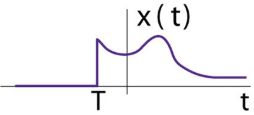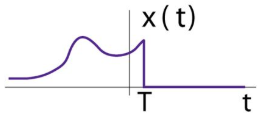A continuous-time signal is said to be a right-sided signal if there exists a T such that for all t < T, x(t) = 0. A discrete-time signal is said to be a right-sided signal if there exists a T such that for all n < T, x[n] = 0.

A continuous-time signal is said to be a left-sided signal if there exists a T such that for all t > T, x(t) = 0. A discrete-time signal is said to be a left-sided signal if there exists a T such that for all n > T, x[n] = 0.

A continuous-time signal or discrete-time signal is said to be a two-sided signal if it is not a left-sided signal and it is not a right-sided signal.

